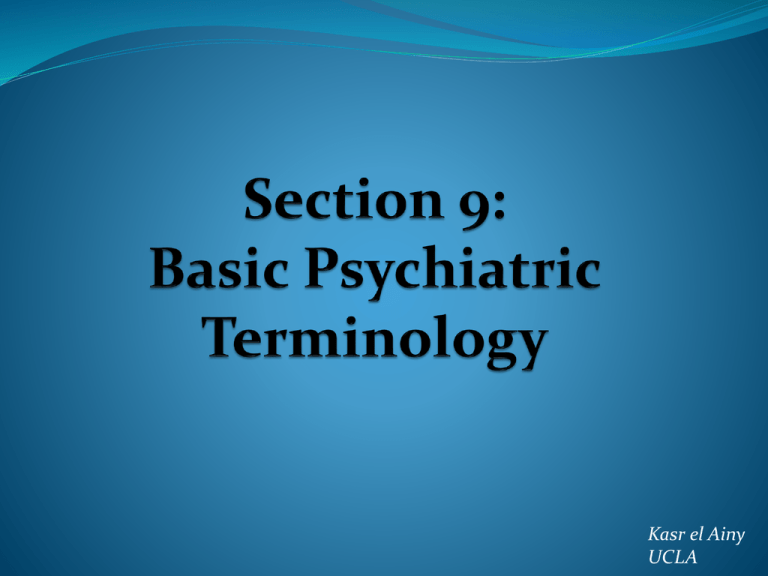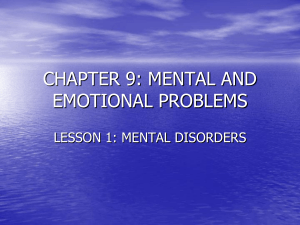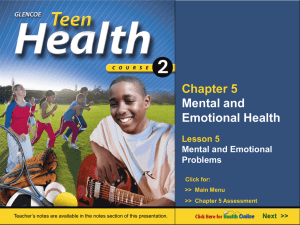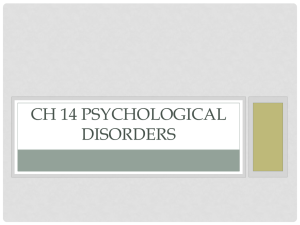Section 9_Basic Psych Terminology
advertisement

Kasr el Ainy UCLA Definition Psychiatry is that branch of medicine dealing with mental disorder and its treatment Psych: soul or mind Iatros: healer Common confusions within psychiatry Psychology: a science that investigates behaviour, experience, and normal functioning of the mind Psychotherapy: the treatment of psychological issues by non-physical means Psychoanalysis: a particular sort of psychotherapy, or means of exploring the unconscious mind Non-medical practitioners • psychologists • psychotherapists • therapists • social workers Etiology of Psychiatric Disorders The Bio-Psycho-Social Model of Etiology According to this model psychiatric disorders arise from the combined effect or interaction of biological, psychological and social factors. Biological, psychological and social factors create a vulnerability (i.e. readiness) to develop certain psychiatric disorders. Psychiatric Symptoms and Signs Disorders of Perception • Illusions: Misinterpretation of real external sensory stimuli (e.g., mistaking a rope for a snake, mirage). • Hallucinations: False perception in the absence of any external stimulus Disorders of Emotions A-Mood: a sustained and pervasive emotional tone subjectively experienced and reported by the patient and observed by others (e.g., depression, elation, anger). B- Affect: usually used to indicate the subjective and immediate "short lived" or transient experience of emotion. It also refers to the external expression or observed aspect of emotions. Disorders of Emotions A- Disorders of Mood: Euthymic mood is normal range of mood (implying absence of abnormal or pathological moods). Disorders of mood may be unpleasant or pleasant. Disorders of Emotions Unpleasant Moods 1. Dysphoric mood: an unpleasant mood; a mood of general dissatisfaction. 2. Irritable mood: easily annoyed and provoked to anger. 3. Depression: feeling of sadness. 4. Anhedonia: lack of the ability to experience pleasure and loss of interest in all regular pleasurable activities. 5. Fear: unpleasant emotional state in response to a realistic threat or danger. Disorders of Emotions Unpleasant Moods 6. Anxiety: feeling of apprehension anticipation of an ill-defined danger. caused by 7. Free-floating anxiety: pervasive unfocused fear not attached to any idea. 8. Tension: unpleasant increase of psychological activity. motor and 9. Phobia: fear related to a particular object or situation. Disorders of Emotions Pleasant Moods 1. Euphoria: .exaggerated feeling of well-being that is inappropriate to real events. 2. Elation: elevated mood with feelings of joy, euphoria and intense self-satisfaction and optimism. 3. Ecstasy: feeling of intense elation. Disorders of Emotions B- Disorders of Affect: These are disturbances related to observed expression of emotions. They include the following disorders: 1. Constricted or restricted affect: reduced intensity of externalized feeling tone (i.e., affective expression and responsivity). 2. Blunted affect: severe reduction in the intensity of emotional expression and responsivity. 3. Flat affect (apathy): absence or near absence of any signs of emotional expression or responsivity. Disorders of Emotions Disorders of Affect continued… 4.Inappropriate affect (incongruity of affect): disharmony between expressed affect and the associated thought or situation. 5. Lability of affect (emotional incontinence): affective expression characterized by frequent and abrupt changes unrelated to external stimuli. 6. Swings of affect: Oscillation of a person's emotional feeling tone between periods of elation and periods of depression or other mood states. 7. Ambivalence: Coexistence of two opposing affects or impulses toward the same object at the same time. Anxiety Disorders 1. Generalized anxiety disorder (GAD): generalized, persistent state of anxiety not related to a certain stimulus. 2. Panic disorder: Discrete attacks of anxiety with no external stimulus. 3. Phobic disorder: anxiety related to certain stimuli. Anxiety Disorders continued… 4.Obsessive-Compulsive Disorders (OCD): anxiety is provoked by attempts at resisting obsessions and compulsions. 5. Posttraumatic Stress Disorder (PTSD): anxiety symptoms following exposure to a life-threatening situation. N.B. Anxiety disorders associated with substance abuse/dependence or with a general medical condition are diagnosed according to their etiological factor. A Closer Look: Anxiety Common Symptoms of Anxiety Disorders Heart palpitations, sweating, tremors, nausea, dizziness, fear of losing control, going crazy Excessive worry and fear, difficulty controlling these thoughts Difficulty concentrating or mind “going blank” Easily irritated Difficulty falling or staying asleep Mood Disorders A- Depressive Disorders: Common types of Depressive Disorders are: Major Depressive Disorder Dysthymic Disorder. A Closer Look: Depression Common Symptoms of Depression Appearance of being sad, tearful, no emotions, or easily irritated and upset Loss of interest or pleasure in most activities Loss of energy/ feelings of being tired most of the day Significant weight loss or gain Difficulty sleeping or sleeping excessively Talking about death, suicide Mood Disorders B- Bipolar Disorders: A manic episode consists of a distinct period of persistently elevated, expansive, or irritable mood. A hypomanic episode is similar to a manic episode, but the symptoms are not severe enough to cause marked deterioration in either social or occupational functioning. A Closer Look: Bipolar Common Symptoms of Bipolar Disorder Symptoms of Depression and Symptoms of Mania (Mood Swings) Manic symptoms include: High involvement in pleasurable activities that are likely to cause painful consequences Decreased need for sleep, constantly “on the go”, rapid and pressured speech, conversation jumps from one topic to the next Inflated self-esteem or feelings of superiority. A Closer Look: ADHD Common symptoms of ADHD Easily distracted, difficulty staying focused and on task Difficulty staying organized, forgetful, does not complete tasks May talk excessively, be constantly “on-the-go” or having difficulty sitting still A Closer Look: PTSD Common Symptoms of PTSD Must have experienced, witnessed or been confronted with a life threatening event Nightmares or recurrent thoughts/images of the event Avoidance of reminders of the event Constantly watching surroundings for potential threats Easily startles Difficulty concentrating, easily irritated Organic Mental Disorders Cognitive disorders: Organic menial disorders in which the most prominent features are disturbances of cognitive functions which may be associated with disturbed consciousness. Cognitive disorders include 3 main syndromes: 1 . Delirium 2. Dementia 3. Amnestic disorders Psychosis Psychosis is a loss of contact with reality, usually including false beliefs about what is taking place or who one is (delusions) and seeing or hearing things that aren't there Psychosis Common Symptoms of Psychosis Disorganized thought and speech False beliefs that are not based in reality (delusions), especially unfounded fear or suspicion Hearing, seeing, or feeling things that are not there (hallucinations) Thoughts that "jump" between unrelated topics (disordered thinking) Schizophrenia Schizophrenia is defined as a chronic psychotic disorder that shows marked disturbance in thought, mood, and behavior that lead to impaired functioning and deterioration of personality. Schizophrenia In more precise terms, schizophrenia is described as "a disturbance that lasts for at least 6 months and includes at least a month of active phase symptoms; that is, two or more of the following: delusions hallucinations disorganized speech grossly disorganized or catatonic behavior negative symptoms (i.e.. affective flattening or avolition) Personality Disorders The following are the classical types of Personality Disorders: 1. Schizoid Personality Disorder: Marked preference to do things alone (socially withdrawn). Constricted emotions. Distant and cold. Touchy, sensitive to feeling of rejection. Personality Disorders 2. Paranoid Personality Disorder Grandiose feelings. He feels insecure. He overestimates minor events. He searches to confirm suspicions in others. He cannot relax. He is envious and pathologically jealous. Personality Disorders 3. Antisocial Personality Disorder Constant lack of conformity to major societal, moral and religious rules. Criminal versatility. Poor impulse control. Avoids responsibility for actions. Substance abuse. Personality Disorders 4. Histrionic Personality Disorder Immature personality, emotionally unstable, and tends to emotionally overreact. He craves and works to be constantly the centre of attraction. Dramatization of situations and emotions. Sexually provocative and seductive. Personality Disorders 5. Obsessive-Compulsive Personality Disorder Over concern with details. Perfectionist. Rigid and inflexible, insists that things be done in his own way. Indecisiveness and hesitancy. Over conscientious. Somatoform Disorders 1. Somatization Disorder 2. Conversion Disorder 3. Hypochondriasis Eating Disorders They are a group of disorders where there is excessive preoccupation with weight, food, and body shape. Two main types are recognized: 1. Anorexia Nervosa 2. Bulimia Nervosa Activity: Small Group Discussion A client you are counseling has recently been diagnosed with an anxiety disorder for which her physician prescribed her an antidepressant. The client is concerned because she does not suffer from depression and is wondering if an antidepressant will actually reduce her symptoms. As a group, discuss what information you would provide to your client and how you would counsel her on this issue. Treatment Planning: Dalila married, but argues daily with husband sales clerk at a tourism gift shop husband is an accountant first used Valium and Vicodin in college, mixed with alcohol prescribed antidepressant for her anxiety never experimented with any other drugs history of trauma exposure: car accident that left college roommate disabled; this occurred during college with episodes of binge drinking and prescription drug use that followed the traumatic event no known psychiatric disorders uses pills daily, and alcohol 3-4 times weekly alleges that pills are for sleep problems and untreated fibromyalgia occasionally drives under the influence, but no arrest to date recent emergency room visit for a fall while intoxicated husband is concerned; threatening divorce









